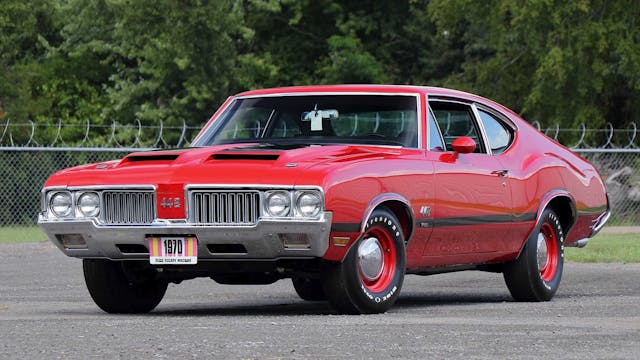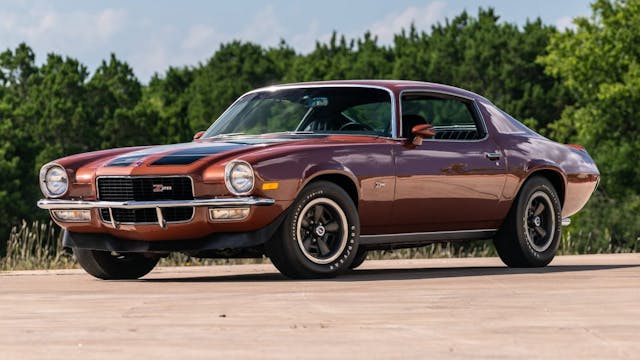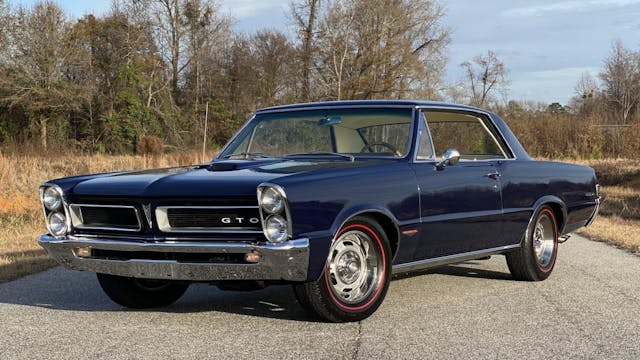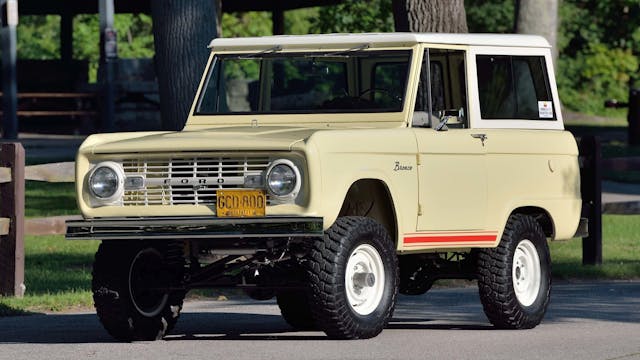Are these 5 familiar classics finally cooling off?
We have all been wondering how long the collector car market’s historic hot streak can carry on, and what the inevitable fall-off might look like. Well, the latest Hagerty Price Guide—updated each quarter—is giving us some clues. Although there were still some surprising gains, we are starting to see decreases, as well.
The cooling off is the muscle car market, which reached all-time highs this year. Now, several of these 1960s and ’70s classics have posted declines.
Some of the reasons for this have to do with supply—we’ve seen lower-quality examples hit the market in recent months. Yet there’s no doubt the broader economy is having an impact. Inflation is hitting us all in the wallet while uncertainty in the stock market is hitting us all in the 401(k). Although classic cars, like many tangible assets, can be a hedge against such bad news, they are also, like other discretionary purchases, subject to pressures on consumers. That’s particularly true for relatively attainable vehicles like muscle cars, which by and large are bought and sold by people of ordinary means.
Note that the drops in the latest guide haven’t erased the gains from the last couple of years. Also, remember that a correction is inevitable and, to a certain extent, healthy, as it indicates the market is being driven by rational buyers and sellers, as opposed to speculators. There’s no doubt, though, that this is a change from the rapid appreciation we’ve all become accustomed to in recent years.
1968-1972 Oldsmobile 4-4-2 W-30 -12%

This generation 4-4-2 is without a doubt peak Oldsmobile muscle. While Oldsmobile’s more visually-reserved approach may not have sold as many cars in an exuberant era of colors named “Plum Crazy” or wild Judge decal packages, the 4-4-2 was no slouch. Looking past the deluxe interior and comparatively staid styling, the W-30 code packed a punch. Peaking with a 455-cubic-inch engine that debuted in 1970 with a respectable 370-horsepower and torque in the 500 lb-ft range, these cars were not to be trifled with.
Over the course of 2021 and the first quarter of 2022, the 4-4-2 experienced increases with the rest of the muscle car market. After spring, it started to lose value while most other top-tier muscle cars held their own. The fact that they have dropped in value two quarters in a row needs to be taken seriously. The net increase over the past 12-months now only stands at a few percent. It is important to keep in mind that we are in a typical lull for this segment, as big players in the muscle car market save their best cars for the upcoming January auctions in Scottsdale and Kissimmee. Nonetheless, the 4-4-2 could very well be a glimpse into the future for the broader muscle segment.
1970-1973 Chevrolet Camaro Z/28 -9%

Late second-generation GM F-bodies have long been a talking point this year, with Bandit-era Trans Ams and Z/28 Camaros being big movers publication over publication. The early-second generation has so far been pulling up the rear, appreciating just behind its younger siblings. To the uninitiated, it might seem odd that these cars would be so widely segmented. The reality is that despite sharing the same generation, they are very different cars. The early Z/28 remained incredibly capable, using the high-compression Corvette-based LT1 350 and hewing closer to Trans Am series roots. The later cars followed the Mustache Muscle theme in that their performance didn’t really live up to their more flashy aesthetic.
Later Z/28s have held fast to their gains over the year, but 1970-73 model years experienced a downturn. This doesn’t negate earlier gains, but it may be a warning sign of things to come for their more popular siblings from the late 70s, and may even have implications for second generation Trans Ams, which usually hold a similar market trajectory.
1964-1967 Chevrolet Chevelle SS -9%

Chevrolet’s Chevelle experienced one of the more interesting transformations over the course of the Muscle Car era. With the hottest version sporting a 327 in 1964 and through much of 1965, it seemed meek compared to the GTO’s 389 and other early entrants into the segment. That changed in late 1965 with the introduction of the 396 big block to the Chevelle’s engine bay. Actual promotion of the more potent plant wouldn’t happen until 1966, but this set the stage for the fire-breathing Super Sport Chevelles that would roll out through the early ’70s.
While the ’68–72 Chevelles held on to their gains much better, ’64–67 Super Sport models experienced a broad softening. Some of the difference could be related to the popularity of the later models, and we are monitoring those cars for signs of a turning tide. As with the other models on this list, these losses don’t negate gains from earlier this year, but it does shine a light on where things could be headed.
1964-1967 Pontiac GTO -7%

Pontiac GTO reigns among Muscle Car royalty as the genesis of the performance segment. Huge interest in the model as well as its historical significance even landed it on our 2022 Bull Market list. It was a heck of a pick as well: the GTO exploded in value, gaining an average of 32 percent in the first portion of the year.
Once late summer arrived, however, prices began to flatten and dip slightly. The seven percent reduction in GTO values is likely attributed to the declining quality of examples hitting the market as well as satisfaction of market demand. As mentioned earlier, due to the sales cycle for these cars, we may not have a real sense of where things are headed until the auctions in January.
1966-1977 Ford Bronco -8%

It’s not a Muscle Car, but we’ve discussed the first generation Ford Bronco for a very long time. Never, though, in terms of softening values. In fact, the first-gen Bronco has been one of the hottest collector vehicles to emerge over the past few years. Values of exceptional, stock examples have regularly tipped the scales at the six-figure mark in 2022.
Broncos have now gotten to a point where the average collector is priced out of the market, and $100,000+ starts to look like a lot of money for a utilitarian vehicle with few amenities. But let’s be honest here, we don’t buy classic trucks for the amenities. In the grand scheme, an 8-percent loss on early Broncos isn’t that much. However, zoom out to the rest of the model series and take note: later generations also experienced declines, with some models even seeing value losses in consecutive quarters. While it takes more than one publication to make a trend, it certainly looks like we could finally be at the end of the first-gen Bronco’s unprecedented hot streak.
Check out the Hagerty Media homepage so you don’t miss a single story, or better yet, bookmark it.



Amen on keeping it a hobby! I love 32 Ford street rods, had 5 of them. just finished a 32 coupe at age 80. and don’t really care what the present trend is.
I’ve cut back on the TV auctions when they glorified cars at $300K+. How many car guys do you know who spend th0000at much? Remember who real car guys are, were not “flipper’s” Most of us know they are a money pit…so if boating, golf or airplanes, but we love the hobby.
When I was young, car shows were full of Muscle. Folks with money brought their Mustangs and Camaro’s and raced a strip of pavement.
But there were these strange old guys. They wore bib overalls, and Train Engineers’ hats and brought their Model T’s restored to their pristine, original, 50-mph top speed livery. They were as proud of those little putt-putt cars and their performance as the younger guys were of their 150-mph dragsters. We all kind of snickered at them and their antiques. Couldn’t complain about their workmanship, though.
Now we’re the old guys with the same Muscle Cars that were popular back then. And I can tell the younger crowd looks at us the same way as they take their 170-mph Road-Race-bred Porsches, Ferrari’s, and McLarens to the Car shows. The 6-digit crowd is looking down their noses at us.
And that’s why Muscle Cars are losing their value. Even us old guys are opting to buy new European performance and style with our $200,000 rather than old museum pieces that will just depreciate as fewer of us find them exciting.
The good news is that the Muscle cars of the 50’s, 60’s, and 70’s will become more affordable (and attract more attention) for the middle-price hobbyist in the not to distant future.
I’m 65 and agree, buy a older car for personal enjoyment. but if you’re looking for investment, I’d consider 1987 buick grand national, gnx if you can find one. Currently have 1957 Belair, like it for the look and it just feels good to cruise in it.
I agree with all of the posters that it is a generational thing. I turned 81 this year and I still like to work on and drive my 1950’s and 60’s cars.
Being that an early 2nd gen non-RS front end Camaro is my dream car, the prices going down is a good thing. Maybe one day I will actually be able to afford one.
I love my 87 Samurai. Go anywhere.
especially GREAT for the Farm, Frank ! Hold onto it. That’s a keeper!
I had a ‘71 Scout, 232 inline 6, a rare 2WD. Inherited from my Dad who bought it in 1973 from a lady who could not longer “muscle” the massive clutch. It had a steering wheel that could nearly duplicate an 18 wheeler. 3 speed manual with a stump pulling 1st gear. Better for the farm than the highway, but it could have easily defined the term “bullet proof.” Always someone, males and females alike, who wanted to buy it each time I took it out for a spin. The engine never failed to run like a sewing machine – undetectable vibration while idling (even with not so regular maintenance *blush~!). I finally sold it just recently and it’s residing proudly in West Virginia. All that said, it was the old Toyota LandCruisers that I always longed for mainly based on an older buddy that had one that could drive it to its COMPLETE capabilities – ohh the memories!! But those are cramped in the driver’s seat, and may be just as well left as a dream. Sometimes that is GOOD enough!
As for the late 60’s , early 70’s muscle cars ….. LOVE ‘em !
Other than the corvair, which they fixed well before Nader made an issue of it, I can not think of a vehicle that was unsafe in doing what it was designed to do. If you want to drive your Cj like a sports car you are going to have problems. If you are taking your citation off road, …. In a time when things were less reliable, scouts and broncos did a stellar job of taking you to remote places and back again. Especially if you had basic mechanical knowledge. They had a lot of overlap but didn’t really fill the same niche. They may be less capable, less efficient and less reliable than there modern counterparts but they are harder to hurt, easier to fix and are better at doing what they were designed to do than any modern derivative. Now why any one would pay $100k for one is a separate question
What’s the status on a ’66 Olds Toronado? I had one and loved it. Wish I still had it . Lived in Arizona at the time and the big engine drove A/C like a house HVAC. Engine size?…I don’t know…. anybody? I believe Cadillac Eldorado used the same Chassis and engine for the year. Clicking valve lifters, but I pulled them out, cleaned them…then quiet as the wind. Mine was white on blue interior……felt like a jet, and when you sat in it you couldn’t see the end of the hood….:)
It`s about time, these auto auctions like Barret Jackson and especially Mecum who profit from jacked up prices and line their pockets with sellers fees are no friends of the average guy who would cherish owning a driver he could afford. Then you have these people who buy them to flip them for a profit or buy them and never drive them are nothing more then a hindrance to the hobby. What really annoys me is when I see a guy like Dana Mecum start arguing and pressuring a seller throwing his hands in the air to take the reserve off his vehicle so he can make “his fee” from the seller or buyer, perhaps he needs to be told where to get off from the seller as it`s his car not Mecums. His kid is even worse.
Most car guys love the cars they drove in High School, or wish they drove then. That was the late 70’s for me. Late 60’s into the 70’s are the vehicles that intrest me the most. I love the 1977 Bronco that I puchased about 20 yrs ago. I’ve enjoyed the restoration process and enjoy the memories it brings back of my Bronco I had in H.S. Would I purchase a first gen Bronco today if I was in my 20’s or 30’s ? Probably not, the memories overide the practicality,for my generation. Now I’m looking for a 1970 Firebird Formula 400. That’s practical, right ?
I see a couple of very nice first-gen Broncos being driven daily. Yesterday, my son and I passed a well-worn Scout on the freeway. It’s good to see them being used as intended. This list obviously comprises vehicles of a certain era. Perhaps most folks who always wanted one of these and can afford one are now satisfied. Many years ago I literally dreamt of a white 1967 GTO convertible. I never took that leap.
I’m 76. For me it always was Model T’s, 30’s Fords and ’55 to ’59 models (most brands). Nothing like the sound of a flathead Ford.
Values were overheated for a while, and standards for the 442 / GTO / Mustang restos are going up, not down. The cost of getting one to primo condition is up, too, but save for select models, the quality and availability of parts is low. The generation flowing into the hobby has much more diverse taste, and they want to drive them compared to the traditional show vibe of lawn chairs and oldies music. Restomods, trucks, select imports, the dreaded late models all scratch the itch without sweating whether your rocker cover bolts have the right finish, but you can take them out and drive them without sweating the next rock chip or cursing vapor lock.
I would gladly own any of these cars. Sadly I have seen none of these in an affordable place for me.